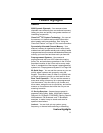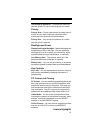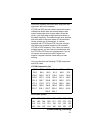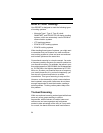
19
Understanding Scanning
Understanding Scanning
This section provides you with background on how
scanning works. You don’t really need to know all of
this to use your scanner, but some background
knowledge will help you get the most from your
BR330T.
Understanding the Scanner’s
Memory
Your scanner’s memory is organized in an architecture
called Dynamic Allocated Channel memory. This type
of memory is organized differently and more efficiently
than the bank/channel architecture used by traditional
scanners. Dynamic Allocated design matches how
radio systems actually work much more closely, making
it easier to program and use your scanner and deter-
mine how much memory you have used and how much
you have left.
Instead of being organized into separate banks and
channels, your scanner’s memory is contained in a
pool. You simply use as much memory as you need in
the pool to store as many frequencies, talk group ID’s,
and alpha tags as you need. No memory space is
wasted, and you can tell at a glance how much
memory you have used and how much remains.
With a traditional scanner, when you program it to
track a trunked system, you must first program the
frequencies. Since you can only program one trunking
system per bank in a traditional scanner, if there were
(for example) 30 frequencies, the remaining channels
in the bank are not used and therefore wasted. Also,
since some trunked systems might have hundreds of
talk groups, you would have had to enter those types
of systems into multiple banks in order to monitor and
track all the ID’s.
What is Scanning?
Unlike standard AM or FM radio stations, most two-
way communications do not transmit continuously.
Your BR330T scans programmed channels until it
Understanding Scanning


















